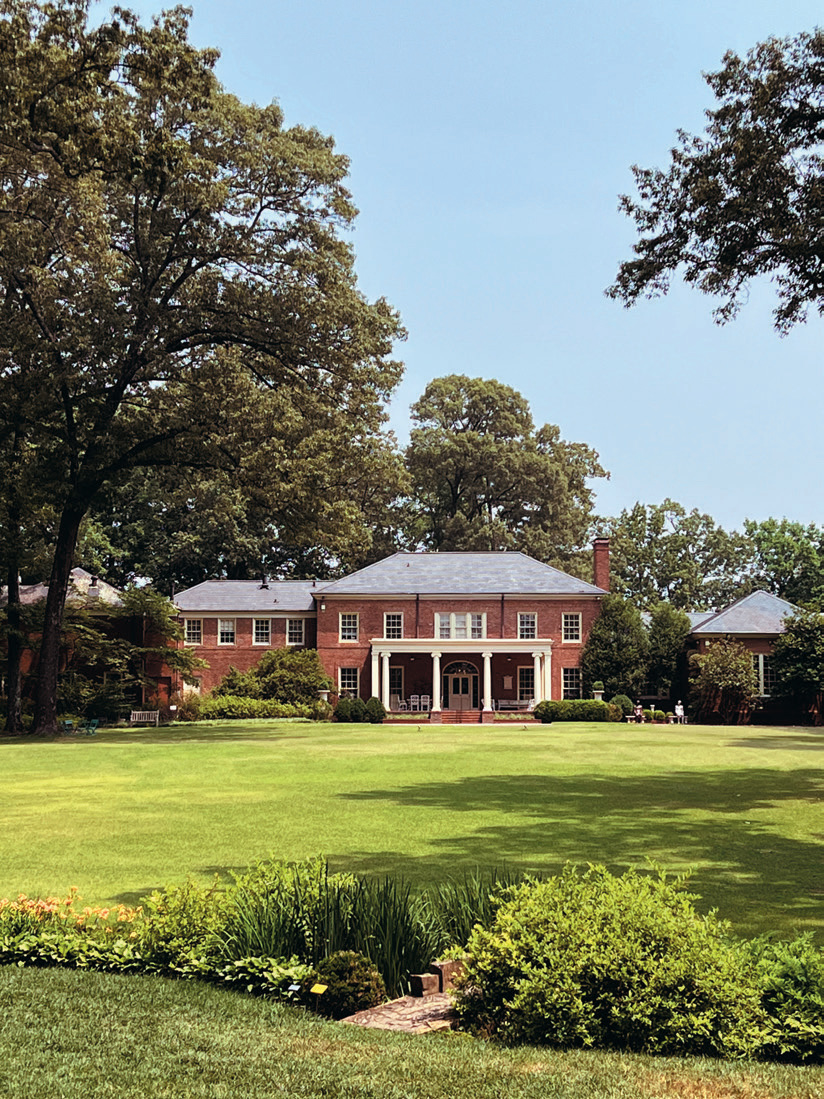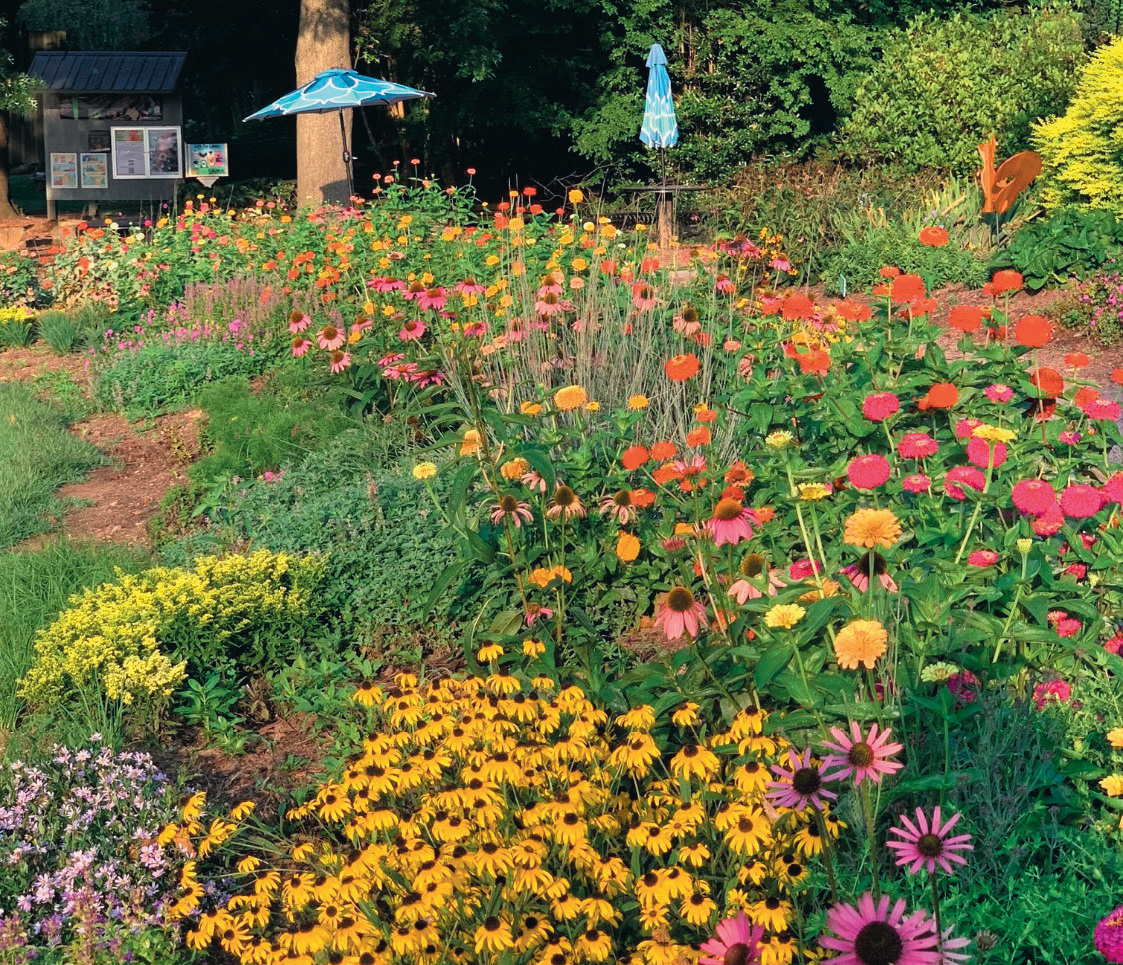Hope in Leoma

Hope Botanical Garden is the little engine that could. Born from the decades-long vision of founder Jerry Clayton, the 4-acre botanical garden in rural Tennessee’s Leoma barely pops up on a Google search for “botanical gardens in Tennessee.”
“With eight themed gardens, Hope Botanical Garden is little, but it’s mighty,” says Clayton, a former environmentalist with the Tennessee Valley Authority. “The focal point is our 2-acre maze created by planting evergreen arborvitae to make the pathways. We think it’s one of the largest all-arborvitae mazes in the country.”
The maze accesses another 2 acres of seven specialty planting areas via its various exits: Visitors Garden, Pink Garden, Meditation Garden, Water Garden, Japanese Garden, Native Garden and Children’s Garden.
“Our planning began in 2017, shortly after I repurchased a 4-acre site that I had sold in 1991,” Clayton says. “It took us five years of transforming the native landscape into our botanical garden, working exclusively with volunteers and funds from donations, fundraising events and sponsorships. Last year, the state of Tennessee gave a nice grant to help make our restrooms ADA-compliant.”

Clayton donated the land; the garden opened on April 22, 2022, as a 501(c)(3) nonprofit organization. Its mission is to promote knowledge, enjoyment and conservation of native and site-adapted plants through display, enjoyment and scientific research.
A reliable group of approximately 20 community members, some of whom are University of Tennessee Extension Master Gardeners or members of area garden clubs, continues to donate time and plants from their own gardens. They help with propagating plants for seasonal sales, teaching classes and setting up for special events.
The board of directors and the all-volunteer staff are listed on the garden’s website.
Hope Botanical Garden offers a place to simply sit and relax, to enjoy nature and learn about plants and the environment. Visitors can receive a private tour as Clayton takes them through the site.
“People who come here tell me there’s just something about this place, that it’s not like any other public garden,” he says. “For me, it’s definitely not about making money. It’s about our labor of love and bringing people together who have a passion for plants, nature and community. We’re continuing to build Hope Botanical Garden one plant at a time.”
Hope Botanical Garden, 16 Ford Road, Leoma. 931-271-5425, hopebotanicalgarden.org.
Combining art and nature

When Memphis philanthropists Margaret Oates Dixon and Hugo Norton Dixon bequeathed their home, gardens and art collection for the enjoyment and education of future generations in 1974, Dixon Gallery and Gardens soon became a destination for people who love classical art, historic architecture and expansive gardens.
Today, the 17-acre estate, which opened as a public garden in 1976, continues to showcase the couple’s Impressionist and Post-Impressionist art pieces, an extensive decorative arts porcelain collection and a sprawling array of four seasons of color ranging from 250,000 tulips each spring to a woodland garden with winding paths beneath a canopy of oak trees.
“The gardens and gallery touch all the right notes for gardeners and art lovers alike,” says Jessie Wiley, director of development and communications for the organization, which is a 501(c)(3) nonprofit. “Our theme is ‘Beauty inside and out,’ and our visitors say it’s true. Where else can you see works by Renoir, Degas, Cézanne and Monet; a historically significant residence from the 1940s; and well-tended and diverse plants and gardens in such a serene and beautiful setting?”
Many of the works in the 2,000-plus-item permanent collection include flowers and horticultural subjects. The interior décor is complemented by flower arrangements from the Memphis Garden Club Cutting Garden.
The gardens are diverse — ranging from traditional layouts, including the Suzanne Mallory Formal Gardens with four different types of boxwoods, to loosely designed pollinator plots that encourage butterflies, birds and insects.
Pathways link open lawns and smaller spaces. In the spring, the grounds are filled with blooming azaleas, dogwood trees, wildflowers and native plants.
Programming focuses on children and youth.
“Our Art to Grow initiative takes arts and gardening into public, private and parochial schools, including to our adopted schools in Shelby County and our nearby ZIP codes. Free art and horticultural lessons spread our mission of education,” Wiley says. “Our pop-up events like Kids in the Garden and our summer camps help children develop an early love of gardening as they plant and harvest vegetables. It’s a fun time for youngsters through hands-on learning.”
Dixon Gallery and Gardens, 4339 Park Ave., Memphis. 901-761-5250, dixon.org.

Statewide outreach open to all

What started in 1983 as a test site for annual bedding plants has grown into a multiple-location showplace for gardeners across the state. Under the umbrella of the University of Tennessee Institute of Agriculture and known as the State Botanical Garden of Tennessee, three sites in Knoxville, Jackson and Crossville comprise extensive public gardens open at no charge.
The majority of financial support for the State Botanical Garden of Tennessee’s three locations is generated by ornamental plant trials, grants, sponsorships and fundraising events like plant sales.
“The gardens were initiated to evaluate seed-grown bedding plants for All-American Selections, an independent nonprofit that tests new, never-before-sold, improved varieties for home gardeners,” says James Newburn, managing director of UT Gardens, Knoxville. “The gardens have now grown to include separate demonstration gardens that highlight the best of the best and are part of the impetus for people to visit.”
For the UT Gardens, trialing and presenting new plants to the public are only part of the story. Education, research and growing new gardeners factor heavily at all three sites.
The 10-acre UT Gardens, Knoxville, offers adult workshops, youth programs and summer camps, school field trips and tours while also serving as the living laboratory for collegiate classes in everything from plant identification to plant disease to insects to art. More than 25 specialized areas include a kitchen garden, a rose garden, a hillside perennial walk, a labyrinth, a children’s garden, wetlands, arboretum and an official Monarch Waystation.
“One of the most distinguishing factors about our Knoxville location is our close association with plant science and beyond, including landscape design, forestry and horticulture and other disciplines,” Newburn says. “It’s a win for the gardens and a win for students.”
Soon breeders and seed companies asked to learn how their plants performed in other parts of Tennessee. In response, plant evaluations expanded to the West Tennessee AgResearch and Education Center in Jackson. Under the leadership of horticulturist and gardener Jason Reeves, the program focused on trees, shrubs, ornamental grasses, perennials and vegetables.
UT Gardens, Jackson, also showcases DIY projects for home gardeners such as a glass bottle trellis, various mailbox plantings and upcycled items like bicycles, stoves and even satellite dishes serving as garden art.
In 2012, UT Gardens, Crossville, joined the UT Gardens system. Located at UT Plateau AgResearch and Education Center, it was begun by the Cumberland County Master Gardeners to illustrate the variety of plants best suited for Middle Tennessee and the colder climes of the Cumberland Plateau. Shalena Durkot is garden coordinator.
The UT Gardens, Crossville, also has an extensive educational component. One outstanding feature is the Kinder Garden.
“Engaging children and youth is a priority in all our programs, but Crossville has created Kinder Garden, an initiative to instill a love of gardening and environmental stewardship to the next generation,” Newburn says. “Youngsters are always so curious, and when an activity is interactive and educational, the learning stays with them.”
All campuses of the UT Gardens rely heavily on volunteer programs that utilize trained master gardeners, student interns and other volunteers for the extensive maintenance and creative displays required at each site. They also are essential in providing educational programming.
Recognizing the value of the UT Gardens to green industry professionals as well as homeowners across the state, the Tennessee General Assembly resolved to name the UT Gardens the official State Botanical Gardens of Tennessee. The bill was signed by then-Gov. Bill Haslam in 2013.
“These locations represent three completely different geographic regions of Tennessee — the Tennessee Valley, the Cumberland Plateau and the West Tennessee Delta,” Newburn says. “No matter where you live in the state, you have a comprehensive resource to learn about what grows best in your area, rich access to gardening education and a place to enjoy Mother Nature and all she has to offer.”
Knoxville, University of Tennessee Institute of Agriculture, 2518 Jacob Drive. 865-974-7324, utgardens.tennessee.edu/locations/knoxville/.
Crossville, UT Plateau AgResearch and Education Center, 320 Experiment Station Road. 931-484-0034, utgardens.tennessee.edu/locations/crossville/.
Jackson, West Tennessee AgResearch and Education Center, 605 Airways Blvd. 731-424-1643, westtn.tennessee.edu/ut-gardens-jackson-about-us/.
Gather at these gardens
Following is a list of events at these featured gardens in May.
Fish Fry, May 7, and Mother’s Day Celebration, May 11-12, Hope Botanical Garden, Leoma
Symphony in the Gardens, May 12, Dixon Gallery and Gardens, Memphis
Plateau Discovery Garden Tour — Magnificent May, May 17, UT Gardens, Crossville



